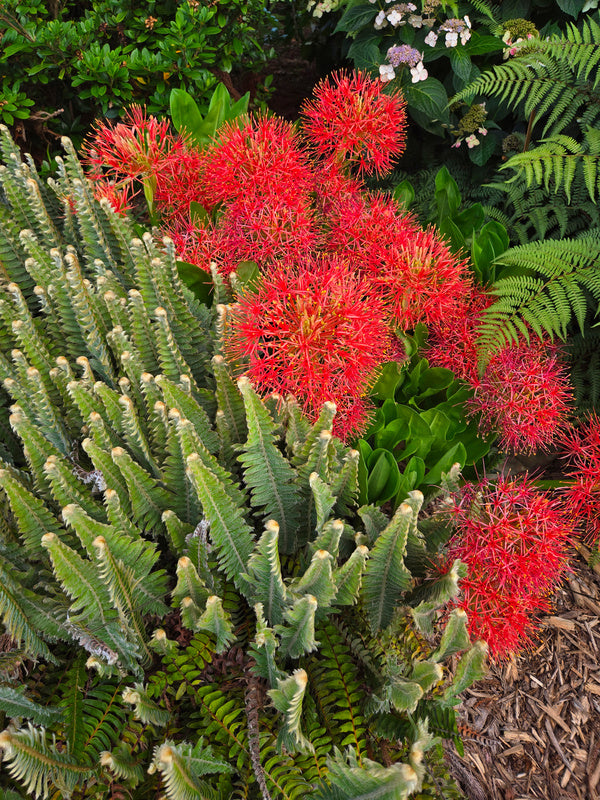The African Blood Lily, also known as Blood Lily, Cape Tulip, Pincushion Flower, and Powderpuff Lily, is a captivating flowering plant from the Amaryllidaceae family. Its botanical name, Scadoxus multiflorus, reflects its vibrant and multifaceted appeal. Native to Africa and the Arabian Peninsula, this bulbous plant is cherished for its dramatic blooms that resemble a powder puff or pincushion.
Planting the African Blood Lily is a straightforward process, making it a popular choice among gardeners. However, caution is advised, as the plant’s roots are toxic and require careful handling. Always wear gloves to prevent skin contact when planting or handling the bulbs.
With its unique appearance and easy propagation, this plant has become a favorite for those looking to add a touch of exotic beauty to their gardens. Explore the essential growing tips and care requirements to ensure the African Blood Lily thrives in your space.
| Common name | African Blood Lily, Blood Lily, Cape Tulip, Pincushion Flower, Powderpuff Lily |
| Botanical name | Scadoxus multiflorus |
| Family | Amaryllidaceae |
| Species | multiflorus |
| Origin | Africa and Arabian Peninsula |
| Life cycle | Bulb |
| Plant type | Bulb |
| Hardiness zone | 9, 10, 11 |
| Sunlight | Full Sun |
| Maintenance | Low |
| Soil condition | High Organic Matter |
| Drainage | Well-Drained |
| Growth rate | Medium |
| Spacing | Less than 12 in. |
| Harvest time | Fall |
| Flowering period | Summer |
| Height | 1 ft. – 2 ft. |
| Flower color | Gold, Yellow |
| Leaf color | Green |
| Fruit color | Orange |
| Fruit type | Berry |
| Fruit benefit | Showy |
| Flower benefit | Showy |
| Uses | Container |
I. Appearance and Characteristics
Scadoxus multiflorus (formerly Haemanthus multiflorus) is a bulbous plant native to most of sub-Saharan Africa from Senegal to Somalia to South Africa. It is also native to the Arabian Peninsula (Saudi Arabia, Yemen, Oman) and to the Seychelles. It is naturalized in Mexico and in the Chagos Archipelago.It is also found in the Indian peninsula.
Common names, some of which are used for other species, include blood lily, ball lily, fireball lily, blood flower, Katherine-wheel, oxtongue lily, poison root and powderpuff lily.
Scadoxus multiflorus grows from a “rhizomatous bulb”, i.e. a bulb which also produces rhizomes (modified underground stems). The leaves and flower may appear together or the leaves may be produced later. The bases of the leaves, the stalks or petioles, are tightly wrapped together to form a pseudostem or false stem, 5–60 cm (2–24 in) long. The flowers are produced in an umbel at the top of a leafless stem (scape), 12–75 cm (5–30 in) long. Both the pseudostem and the scape are often covered with reddish brown to dark violet spots. The bracts under the umbel soon wither.
The umbel of flowers is more-or-less globe shaped, with from 10 to 200 individual flowers. Each flower has a stalk (pedicel) typically 15–45 mm (0.6–1.8 in) long. The tepals, filaments of the stamens and the style are all scarlet, fading to pink. The bases of the tepals are fused to form a cylinder-shaped tube, 4–26 mm (0.2–1.0 in) long; the free ends of the tepals are 12–32 mm (0.5–1.3 in) long, narrow and spreading. The fruit is a berry, 5–10 mm (0.2–0.4 in) across.
Scadoxus multiflorus is chill-sensitive and must be kept at a minimum temperature of 5 °C (41 °F), for forms of southern African origin, up to 10 °C (50 °F) or more for those of tropical origin. An open, well-drained growing medium, largely organic in nature, is recommended. Propagation is by seed. Pests are those of Scadoxus generally.
Scadoxus multiflorus subsp. longitubus is rarely if ever cultivated, although (under the synonym Haemanthus mannii) it was described as having been “introduced” in 1877. Scadoxus multiflorus subsp. multiflorus is produced for sale in large numbers by the Dutch horticultural industry. In cultivated forms, the flowers often appear before the leaves, sometimes not until late summer.
Scadoxus multiflorus subsp. katherinae has been described as “imposing”, sometimes reaching a height of 120 cm (4 ft), with a strong purple-spotted pseudostem. Red berries may be produced, which can last through the winter. The UK National Plant Collection for Scadoxus has described it as “an excellent plant for a glasshouse or sunny windowsill.” In South Africa it can be grown in the open garden in the shade, in well-drained, light soil containing plenty of organic matter. It requires ample water when in growth but must have good drainage when dormant. It will grow under trees provided the soil is sufficiently fertile.

II. How to Grow and Care
Sunlight
Bright, indirect light exposure or partial sun is best, as the blood lily does not handle intense sun well. Afternoon shade is especially beneficial to protect these plants from the effects of the hot afternoon sun.
Temperature and Humidity
These plants prefer warm climate conditions and do best when temperatures are at least 60 degrees Fahrenheit. Being native to Africa, the blood lily cannot tolerate frost or cold weather.
Medium to high humidity is best. If kept indoors, misting the plant or setting it on a tray of pebbles and water will help increase the humidity. Keep it away from harsh drafts near vents or windows.
Watering
Blood lily plants have moderate watering needs; avoid overwatering. Your watering schedule for a blood lily will vary based upon the plant’s growing stage.
When the plant is actively growing, water consistently to keep the soil slightly moist. However, as the plant begins to go dormant, stop regular watering and allow the plant to die off. Water only to prevent the soil and dormant plant from drying out completely. Increase watering when the plant begins to grow again.
Soil
Loamy or sandy soil that is rich in nutrients is ideal for the blood lily. These soil types offer good drainage, which is important since these plants fare poorly in soggy soil.
If potted in containers, mix rich potting soil with sand. This mixture will allow the soil to stay moist while offering excellent drainage, which is important for a healthy plant.
Fertilizing
Fertilize every two weeks during the growing season to encourage healthy growth. A fertilizer high in phosphorus works well for these plants and supports blooming. When the blood lily begins to die off, stop fertilizing. Fertilize again once its dormant period is over.
Propagation
Propagating offsets is a simple way to multiply blood lily plants.
- When offsets appear, allow the offset to stay attached to the mother plant for two growing seasons.
- After this, use sharp snips to cut the offset away from the mother plant, making sure not to damage the root system of either plant.
- Remove the offset and plant in loamy or sandy soil that is moist.
How to Grow from Seed
Blood lilies can be grown from seeds, found with the plant’s red berries.
- Harvest seeds from the berries once the berries fall off or drop when touched. When this happens, remove the berry flesh to get to the seeds.
- Place the seeds on the surface of moist potting soil.
- The seeds will germinate and form a bulb initially before sprouting. Keep the soil moist and allow the bulb to sit dormant. Growth should appear in a few months.
- Once sprouted, plant the bulb in an individual pot or a suitable outdoor location that is warm enough (above 60 degrees Fahrenheit) and with adequate light exposure.
Potting and Repotting
The Blood Lily does not require frequent repotting. In fact, blood lily grows best if it is not disturbed. If you absolutely must repot the plant, gently work the plant out of its container, taking care not to disturb its root system. Repot the plant in a new container with a mix of potting soil and sand. Water generously and allow excess moisture to drain from the pot.
Overwintering
Because the blood lily is not equipped to survive cold temperatures, it’s important to take the necessary steps to overwinter this plant. For plants grown in the garden, dig up the bulbs in fall; place them in peat moss, and move them to a warm area away from frost, such as inside a greenhouse. Keep the bulbs dry.
If the blood lily plant is grown in a pot, move the pot indoors and keep it as a houseplant during the winter. Be sure to provide enough humidity, since indoor air tends to be drier than the plant’s typical growing conditions.
III. Uses and Benefits
- Ornamental uses
Scadoxus Multiflorus is indigenous to tropical east and south Africa. It is cultivated for its stunning blood-red inflorescences, the source of its popular name, blood lily. Where the environment is acceptable, Scadoxus Multiflorus is planted as an ornamental plant at homes for its vividly coloured flowers, either in pots or in the ground.
- Other uses
The genus Scadoxus has some strongly toxic species, containing poisonous alkaloids lethal to animals, such as sheep and goats, that graze on the leaves or bulbs. Scadoxus multiflorus is traditionally used in parts of tropical Africa as a component of arrow poisons and fishing poisons. It is also used in traditional medicine, although in South Africa less so than Scadoxus puniceus.
Find Where to Buy the Best Blood Lily (Scadoxus multiflorus)


















Leave a Reply